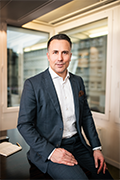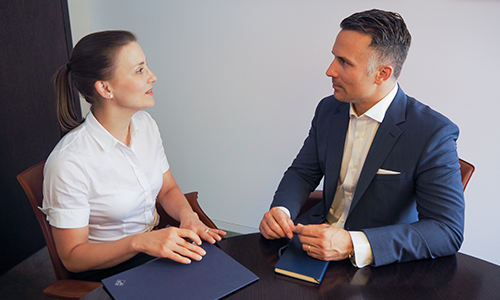Good intentions aren’t enough to make a difference in philanthropy. LGT specialists Julia Kleiser and Rocco Baldinger tell how to avoid the most common pitfalls in giving.
Rocco Baldinger and Julia Kleiser, the philanthropy and foundations sector is undergoing a major shift. What are the primary challenges?
Baldinger: It’s a very dynamic time in the non-profit and philanthropy landscape. The industry faces challenges such as increasing complexity, driven by regulatory requirements as well as self-regulation, digitization as an essential piece of efficient operations, and demands for more transparency. This holds true, especially for fundraising organizations.
Kleiser: In philanthropy, we’re in the midst of a sea change. It's about increasingly identifying the root causes of disadvantage, finding out how global problems are interconnected, and coming up with solutions to address these issues.
This trend towards «systems-change philanthropy» is something we are increasingly discussing with industry leaders.
Are foundations and non-profit organizations in a position to address these challenges?
Baldinger: Those with the strategic, long-term perspective, the willingness, and the operational strength to adapt will be able to make the necessary changes. This should enable them to remain relevant and have the desired impact.
Why isn’t it enough to fund the projects and causes one cares the most about?
Baldinger: Philanthropy and non-profit organizations function differently than for-profit enterprises, where the merits of a product or service stand up to market scrutiny. If you sell a product, you always get a clear indication from your prospective customers whether or not it meets their needs.
This corrective mechanism doesn’t work in philanthropy?
Baldinger: We tend to simply assume all philanthropy is generally sensible, inherently good, and deserves applause. Even if it doesn’t generate a favorable impact or outcome, unfortunately. Sometimes, despite the best of intentions, philanthropy can actually have negative consequences.
«Analyze the landscape and ask yourself: Can your philanthropic work fill a gap?»
Good intentions don’t ensure philanthropy is done well, so it’s crucial for an organization to function efficiently.
How should this process be set up for the widest possible impact?
Kleiser: Passion for achieving positive, sustainable change in a specific area is the beginning – but is there a genuine need? We encourage everyone to do their homework. Analyze the landscape and ask yourself: Can your philanthropic work fill a gap?
Who are the other players out there? Can you collaborate? Initial research may sound boring, but it is essential to achieve systemic change. Otherwise, you risk reinventing the wheel, which may ultimately hinder the intended philanthropic impact.
«It’s essential to first discuss questions of governance»
Baldinger: The methodological questions sometimes come up short in our rush to get to the «doing» part of philanthropy. It’s essential to first discuss questions of governance, and what makes the most sense for one’s own situation as well as for a lasting impact.
Is one of the problems that sometimes not all of the money goes to the end beneficiary?
Kleiser: We often hear «I want my entire donation to go only towards helping disadvantaged kids» – but what about paying the qualified staff implementing impactful programs? Of course, we all want our charitable contributions to have the greatest possible favorable impact.
However, the profound issues of our time require multi-layered interventions.
Can you give us an example?
Kleiser: Let’s take human trafficking. With such a complex topic, it’s essential that philanthropic interventions contribute to research, advocacy, and training as well as building capacity and infrastructure of impactful organizations to tackle the root issues.
Only part of the funding may be used directly to remove a trafficking victim from a dangerous situation.
What’s a sensible level of overhead?
Kleiser: I would turn it around and ask what the organization is trying to achieve. Is there a clear definition of the organization’s aim? Are their interventions transparent, plausible and impactful? It is essential to learn which are the right questions to ask and what quality looks like in impactful charitable organizations.
Baldinger: Unnecessary costs can also be avoided if foundations are structured, regularly evaluated, and monitored, including for effectiveness. Peter Drucker’s maxim that what gets measured gets managed can apply in the non-profit world as much as it does in business.
«Charitable work needs to be viewed holistically»
The leadership of foundations should have a structure and procedures to monitor whether the organization is achieving the goals it has set itself with its funding. Transparency and accountability are key concepts here. In addition, this very approach underscores the credibility of an organization and thus recognizes the great personal commitment of its employees.
What are the most common mistakes in the non-profit world?
Baldinger: Generally speaking, foundations have in recent years become much more professional and rigorous in the way they work, in step with increasing (self-)regulation. Nonetheless, we sometimes observe that foundations lack a clear strategic approach.
Charitable work needs to be viewed holistically, before taking any action. The long-term, perhaps boring, organizational questions are a consequence of the essential strategic work and are crucial for an efficient, sustainable impact.
What is a bank’s role in this – after all, a profit-driven institute has its own agenda.
Baldinger: LGT and its owner-family have a long history of philanthropy, rooted in long-held values. This gives us an inherent understanding of foundations that want to remain relevant in the sector and seek efficiency.
Kleiser: We’re an enabler or facilitator for those seeking a way to maximize their philanthropic impact. Through our network, we can provide access to like-minded philanthropists internationally as well as build a bridge to academia. Last year, we co-published a study on charitable giving in the Middle East with the Cambridge Centre for Strategic Philanthropy.
«It is less a question of size than of expertise in the area»
In a sector that’s been known to reinvent the wheel, we connect philanthropists with similar passions and activities. This way, they can make use of synergies and enhance collaboration.
Many banks are professionalizing their philanthropy advisory services. Isn’t bigger and more experienced better?
Kleiser: It is less a question of size than of expertise in the area, culture, and tradition of the bank. LGT Group allocates a minimum of ten percent of annual dividends to philanthropic activities including LGT Venture Philanthropy, a highly professional foundation with over 15 years of giving experience.
This commitment from the Princely Family is distinctive in the wealth management industry and a key element of our sustainability strategy. It also means the family has longstanding direct experience of philanthropic giving.
Baldinger: Our practical expertise in finance for non-profit organizations and associations as well as our emphasis on long-term relationships where we meet at eye level is a distinguishing characteristic. I have first-hand experience as a foundation board member, for example, in how the merger of two foundations can be planned and carried out.
As a private bank focused on sustainability, LGT has both the traditional wealth management offering as well as access to a proven private equity impact platform, Lightrock.
 Julia Kleiser has been a philanthropy advisor for LGT Private Banking since 2021. With over 15 years of professional experience, she previously worked in UBS’ philanthropy department and for the Mercator Foundation in Germany. She holds a Master’s in international affairs from the Geneva Graduate Institute of International and Development Studies. She contributed to the LGT Guide to Strategic Philanthropy.
Julia Kleiser has been a philanthropy advisor for LGT Private Banking since 2021. With over 15 years of professional experience, she previously worked in UBS’ philanthropy department and for the Mercator Foundation in Germany. She holds a Master’s in international affairs from the Geneva Graduate Institute of International and Development Studies. She contributed to the LGT Guide to Strategic Philanthropy.
 Rocco Baldinger is a senior relations manager at LGT Bank (Switzerland) and oversees a team that caters to non-profit organizations. Before, he was with Credit Suisse in various roles. He has experience as a foundation manager and board member and has a Master’s in Business Consulting from the ZHAW and a Bachelor of Science FHNW in Economics. He is certified to oversee pension funds in Switzerland.
Rocco Baldinger is a senior relations manager at LGT Bank (Switzerland) and oversees a team that caters to non-profit organizations. Before, he was with Credit Suisse in various roles. He has experience as a foundation manager and board member and has a Master’s in Business Consulting from the ZHAW and a Bachelor of Science FHNW in Economics. He is certified to oversee pension funds in Switzerland.










